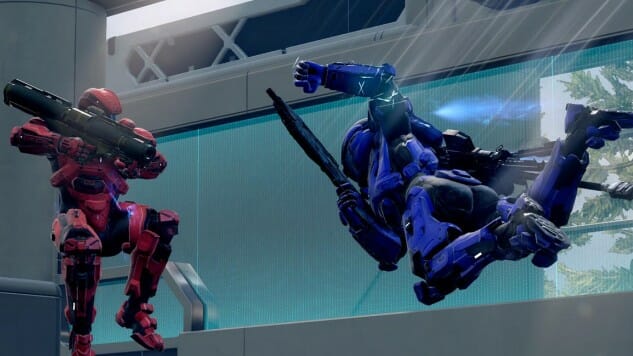Halo 5: Guardians Multiplayer: You Have to Want It

Earlier this week we reviewed Halo 5’s single-player campaign. Now that we’ve had time to experience the multi-player on public servers, we finish our review of Halo 5.
In broad terms, there’s two ways of reviewing any multiplayer experience. The first is that you can talk about the mechanical nature of that experience. You can explain weapon reload timings, the downtime between ability uses, the variety and structure of arenas, the best engagement tactics for given conditions, and anything else that boils down to explaining how each piece moves in the game of chess. The second is that you can talk about the emotional nature of that experience. How do these elements make you feel, and more importantly, when other people access these elements at the same time, how do your combined actions make you feel?
I’m increasingly interested in this second mode of evaluation. The emotions that a multiplayer game facilitates within a group of people through its design makes or breaks my desire to play a game, full stop. When Heroes of the Storm creates a readout where every player can evaluate the individual contributions of each of their team members during the match, it creates a system where a short-term downswing in performance can become a site for bullying. When Destiny’s loot system creates objective optimal loadout choices where a player can be rejected out of hand for not having made those choice, it does the same.
I honestly believe that evaluating Halo 5: Guardians’ multiplayer mechanics and afforded emotions alongside one another is the only thing that’s left, as this review will demonstrate, because the only thing left to say about the Guardians multiplayer is that it is a Halo multiplayer experience.
If you’ve played a Halo game’s multiplayer mode, you’ve played every Halo multiplayer mode to some degree. While there are an extreme number of small changes, the broad strokes are so broad as to constitute a genre all of their own. You control a space marine who has an overshield with quite a bit of health that can be taken down via damage from enemy weapons. That overshield regenerates after a short time of inaction, and if you’re shot while it is down you will more than likely die. Some weapons destroy that shield quickly, like grenades, but every weapon is going to eat through the shield really fast if you’re being shot in the head.
The game is completely balanced around this regenerating shield. Your move speed, your jump height, and your ability to use a button to dash a short distance are all gauged around how likely it is that someone would be able to shoot you for a sustained amount of damage before you can run, jump or dash away. When you’re trapped out in the open, it feels profoundly unfair. When you’re in tight corridors, a relative rarity in Halo design, you might be able to dodge around. In general, if you’re being shot for more than 1/10th of a second, you’re probably going to have to respawn in a few seconds.
Halo 5 is positioned as a game moving toward the edges of the Halo combat genre. A player who was chatting in a game I played put it succinctly, saying that he loved the game because it was the “perfect” combination of Halo and Call of Duty shooter mechanics. While that might be overstating things, Halo 5 is undeniably borrowing design elements from other shooters in the contemporary scene, including Advanced Warfare and Destiny. The ability to do a damaging forward dash, a “ground pound” dash into the ground, and to aim down the sights of your weapon creates a feeling that there is a wide range of abilities for your previously generic Spartan to do. While the Halo games have used class abilities in the past to enable different playstyles, the franchise is still very much anchored in the shooter mechanics of the 1990s and early 2000s in which the real differences between players were not decided in loadout choice but rather through map knowledge and developed skill.
The Call of Duty multiplayer combat since Call of Duty 4 has relied on a lot of player knowledge about the tuning of the games systems. Having knowledge of the maps, character jump heights, and animation timings are important in that game, but just as important is knowing that there are certain items and weapons that equate to hot garbage. The playerbase quickly figures out what the best statistical loadouts are, and those few weapons become the finite selections for players who are even semi-serious about playing the game. You create your loadout, you play that loadout, and you can generally excel against the general field of players. When I handed the controller over to a friend who hadn’t played any of the Halo games, he pretty quickly decided to play another game. “It seems like it’s a game for Halo players,” he said before turning to a game he thought was a little more welcoming to new players: Metal Gear Online.
Halo 5 steadfastly holds onto a kind of Unreal Tournament style of combat in most of its playlists. Everyone starts with the same weapons, and through building knowledge about the game you can plot the best routes to the best weapons pickups. There’s no pre-planning on what kind of build you might go for other than what the level itself will provide you with. It’s a pure meritocracy out there in the killing fields, and for better or for worse that’s what you’re left with.
In team-based Arena playlists, it makes for decent play. Your team ends up having specialists (someone will have the scattergun; another will camp the sniper rifle spawn). Each person, without external communication, can generally figure out what other people are doing and respond in a helpful (or blockading) way. On a mechanical level, the game feels balanced around these team deathmatch, point capture and capture the flag modes. The power level of weapons never gets out of hand, and with there being such a hard focus on a “goal,” there’s very little room for people to break off into shards. When you have a team even vaguely in concert, it feels good to play. If people are on voice, they chat idly.
-

-

-

-

-

-

-

-

-

-

-

-

-

-

-

-

-

-

-

-

-

-

-

-

-

-

-

-

-

-

-

-

-

-

-

-

-

-

-

-











































